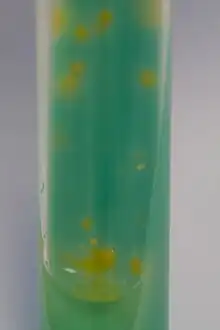Mycobacterium kansasii
| Mycobacterium kansasii | |
|---|---|
 | |
| Scientific classification | |
| Domain: | Bacteria |
| Phylum: | Actinomycetota |
| Class: | Actinomycetia |
| Order: | Mycobacteriales |
| Family: | Mycobacteriaceae |
| Genus: | Mycobacterium |
| Species: | M. kansasii |
| Binomial name | |
| Mycobacterium kansasii Hauduroy 1955,[1] ATCC 12478 | |
Mycobacterium kansasii is a bacterium in the Mycobacterium genus. It is an environmental bacteria that causes opportunistic infections in humans, and is the one of the leading mycobacterial causes of human disease after tuberculosis and leprosy.[2]
Description
Gram-positive, nonmotile, moderately-long to long, and acid-fast rods.
Colony characteristics
It forms smooth to rough colonies after 7 or more days of incubation and is considered a slow grower. Colonies grown in dark are nonpigmented, when grown in light or when young colonies are exposed briefly to light, colonies become brilliant yellow (photochromogenic) according to the Runyon classification of Non-Tuberculous Mycobacteria. Oxygen is essential for the development of the pigment. If grown in a lighted incubator, most strains form dark red crystals of β-carotene on the surface and inside of colony.
Physiology
Its physiology is described as growth on Middlebrook 7H10 agar at 37°C within 7 days or more, resistant to pyrazinamide and susceptible to ethambutol.
Differential characteristics
It is closely related to the non-pathogenic, also slowly growing, nonpigmented, M. gastri. Both species share an identical 16S rDNA but differentiation is possible by differences in the ITS and hsp65 sequences. A commercial hybridisation assay (AccuProbe) to identify M. kansasii exists.
M. kansasii complex
Several former subtypes of M. kansasii have been reclassified as closely related species, and along with M. gastri form the M. kansasii complex (MKC). The species in the MKC are
Type strain
First and most frequently isolated from human pulmonary secretions and lesions.
Strain ATCC 12478 = CIP 104589 = DSM 44162 = JCM 6379 = NCTC 13024.
Discovery
Mycobacterium kansasii was first described in 1952 after being identified as the cause of two cases of disease resembling human pulmonary tuberculosis at Kansas City General Hospital and the University of Kansas Medical Center.[5]
Infection

M. kansasii may cause chronic human pulmonary disease resembling tuberculosis.[6]
Extrapulmonary infections, such as cervical lymphadenitis in children, cutaneous and soft tissues infections, and musculoskeletal system involvement are uncommon. Rarely it causes disseminated disease in patients with severely impaired cellular immunity (such as organ transplants or AIDS). Pre-existing lung disease such as silicosis is a risk factor.[7]
Mycobacterium kansasii occasionally involves the skin in a sporotrichoid pattern.[8]: 341
It is unclear where people acquire the infection and person-to-person spread is not thought to occur. Tap water is believed to be the major reservoir associated with human disease.[9] Biosafety level 2 is indicated.
References
- ↑ Hauduroy P (1955). Derniers aspects du monde des mycobactéries. Paris: Masson et Cie. OCLC 876707134.
- ↑ Johnston JC, Chiang L, Elwood K (January 2017). Schlossberg D (ed.). "Mycobacterium kansasii". Microbiology Spectrum. 5 (1). doi:10.1128/microbiolspec.TNMI7-0011-2016. PMID 28185617.
- ↑ Luo T, Xu P, Zhang Y, Porter JL, Ghanem M, Liu Q, et al. (May 2021). "Population genomics provides insights into the evolution and adaptation to humans of the waterborne pathogen Mycobacterium kansasii". Nature Communications. 12 (1): 2491. Bibcode:2021NatCo..12.2491L. doi:10.1038/s41467-021-22760-6. PMC 8093194. PMID 33941780.
- ↑ Tagini F, Aeby S, Bertelli C, Droz S, Casanova C, Prod'hom G, et al. (June 2019). "Phylogenomics reveal that Mycobacterium kansasii subtypes are species-level lineages. Description of Mycobacterium pseudokansasii sp. nov., Mycobacterium innocens sp. nov. and Mycobacterium attenuatum sp. nov". International Journal of Systematic and Evolutionary Microbiology. 69 (6): 1696–1704. doi:10.1099/ijsem.0.003378. PMID 30950782. S2CID 96435266.
- ↑ Buhler VB, Pollak A (April 1953). "Human infection with atypical acid-fast organisms; report of two cases with pathologic findings". American Journal of Clinical Pathology. 23 (4): 363–374. doi:10.1093/ajcp/23.4.363. PMID 13040295.
- ↑ Mycobacterium Kansasii at eMedicine
- ↑ Webster Jr JR, Cugell DW, Bazley ES, Harrison III RW, Bugaieski SM, Buckingham WB (1969-06-01). "Silicosis and Mycobacterium Kansasii Infection". Diseases of the Chest. 55 (6): 479–482. doi:10.1378/chest.55.6.479.
- ↑ James WD, Berger TG, et al. (2006). Andrews' Diseases of the Skin: clinical Dermatology. Saunders Elsevier. ISBN 978-0-7216-2921-6.
- ↑ Vaerewijck MJ, Huys G, Palomino JC, Swings J, Portaels F (November 2005). "Mycobacteria in drinking water distribution systems: ecology and significance for human health". FEMS Microbiology Reviews. 29 (5): 911–934. doi:10.1016/j.femsre.2005.02.001. PMID 16219512.
External links
- "Mycobacterium kansasii". NCBI Taxonomy Browser. 1768. Archived from the original on 2022-06-20. Retrieved 2023-01-28.
- Type strain of Mycobacterium kansasii at BacDive - the Bacterial Diversity Metadatabase Archived 2017-05-10 at the Wayback Machine